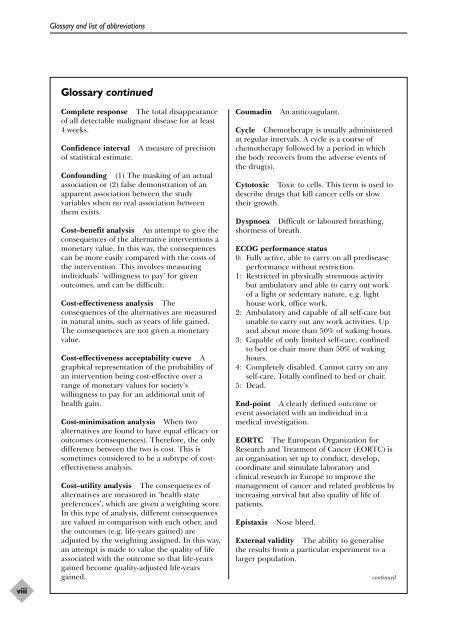Docetaxel with prednisone or prednisolone for the treatment of ...
Docetaxel with prednisone or prednisolone for the treatment of ...
Docetaxel with prednisone or prednisolone for the treatment of ...
You also want an ePaper? Increase the reach of your titles
YUMPU automatically turns print PDFs into web optimized ePapers that Google loves.
viii<br />
Glossary and list <strong>of</strong> abbreviations<br />
Glossary continued<br />
Complete response The total disappearance<br />
<strong>of</strong> all detectable malignant disease f<strong>or</strong> at least<br />
4 weeks.<br />
Confidence interval A measure <strong>of</strong> precision<br />
<strong>of</strong> statistical estimate.<br />
Confounding (1) The masking <strong>of</strong> an actual<br />
association <strong>or</strong> (2) false demonstration <strong>of</strong> an<br />
apparent association between <strong>the</strong> study<br />
variables when no real association between<br />
<strong>the</strong>m exists.<br />
Cost–benefit analysis An attempt to give <strong>the</strong><br />
consequences <strong>of</strong> <strong>the</strong> alternative interventions a<br />
monetary value. In this way, <strong>the</strong> consequences<br />
can be m<strong>or</strong>e easily compared <strong>with</strong> <strong>the</strong> costs <strong>of</strong><br />
<strong>the</strong> intervention. This involves measuring<br />
individuals’ ‘willingness to pay’ f<strong>or</strong> given<br />
outcomes, and can be difficult.<br />
Cost-effectiveness analysis The<br />
consequences <strong>of</strong> <strong>the</strong> alternatives are measured<br />
in natural units, such as years <strong>of</strong> life gained.<br />
The consequences are not given a monetary<br />
value.<br />
Cost-effectiveness acceptability curve A<br />
graphical representation <strong>of</strong> <strong>the</strong> probability <strong>of</strong><br />
an intervention being cost-effective over a<br />
range <strong>of</strong> monetary values f<strong>or</strong> society’s<br />
willingness to pay f<strong>or</strong> an additional unit <strong>of</strong><br />
health gain.<br />
Cost-minimisation analysis When two<br />
alternatives are found to have equal efficacy <strong>or</strong><br />
outcomes (consequences). Theref<strong>or</strong>e, <strong>the</strong> only<br />
difference between <strong>the</strong> two is cost. This is<br />
sometimes considered to be a subtype <strong>of</strong> costeffectiveness<br />
analysis.<br />
Cost–utility analysis The consequences <strong>of</strong><br />
alternatives are measured in ‘health state<br />
preferences’, which are given a weighting sc<strong>or</strong>e.<br />
In this type <strong>of</strong> analysis, different consequences<br />
are valued in comparison <strong>with</strong> each o<strong>the</strong>r, and<br />
<strong>the</strong> outcomes (e.g. life-years gained) are<br />
adjusted by <strong>the</strong> weighting assigned. In this way,<br />
an attempt is made to value <strong>the</strong> quality <strong>of</strong> life<br />
associated <strong>with</strong> <strong>the</strong> outcome so that life-years<br />
gained become quality-adjusted life-years<br />
gained.<br />
Coumadin An anticoagulant.<br />
Cycle Chemo<strong>the</strong>rapy is usually administered<br />
at regular intervals. A cycle is a course <strong>of</strong><br />
chemo<strong>the</strong>rapy followed by a period in which<br />
<strong>the</strong> body recovers from <strong>the</strong> adverse events <strong>of</strong><br />
<strong>the</strong> drug(s).<br />
Cytotoxic Toxic to cells. This term is used to<br />
describe drugs that kill cancer cells <strong>or</strong> slow<br />
<strong>the</strong>ir growth.<br />
Dyspnoea Difficult <strong>or</strong> laboured breathing,<br />
sh<strong>or</strong>tness <strong>of</strong> breath.<br />
ECOG perf<strong>or</strong>mance status<br />
0: Fully active, able to carry on all predisease<br />
perf<strong>or</strong>mance <strong>with</strong>out restriction.<br />
1: Restricted in physically strenuous activity<br />
but ambulat<strong>or</strong>y and able to carry out w<strong>or</strong>k<br />
<strong>of</strong> a light <strong>or</strong> sedentary nature, e.g. light<br />
house w<strong>or</strong>k, <strong>of</strong>fice w<strong>or</strong>k.<br />
2: Ambulat<strong>or</strong>y and capable <strong>of</strong> all self-care but<br />
unable to carry out any w<strong>or</strong>k activities. Up<br />
and about m<strong>or</strong>e than 50% <strong>of</strong> waking hours.<br />
3: Capable <strong>of</strong> only limited self-care, confined<br />
to bed <strong>or</strong> chair m<strong>or</strong>e than 50% <strong>of</strong> waking<br />
hours.<br />
4: Completely disabled. Cannot carry on any<br />
self-care. Totally confined to bed <strong>or</strong> chair.<br />
5: Dead.<br />
End-point A clearly defined outcome <strong>or</strong><br />
event associated <strong>with</strong> an individual in a<br />
medical investigation.<br />
EORTC The European Organization f<strong>or</strong><br />
Research and Treatment <strong>of</strong> Cancer (EORTC) is<br />
an <strong>or</strong>ganisation set up to conduct, develop,<br />
co<strong>or</strong>dinate and stimulate lab<strong>or</strong>at<strong>or</strong>y and<br />
clinical research in Europe to improve <strong>the</strong><br />
management <strong>of</strong> cancer and related problems by<br />
increasing survival but also quality <strong>of</strong> life <strong>of</strong><br />
patients.<br />
Epistaxis Nose bleed.<br />
External validity The ability to generalise<br />
<strong>the</strong> results from a particular experiment to a<br />
larger population.<br />
continued
















